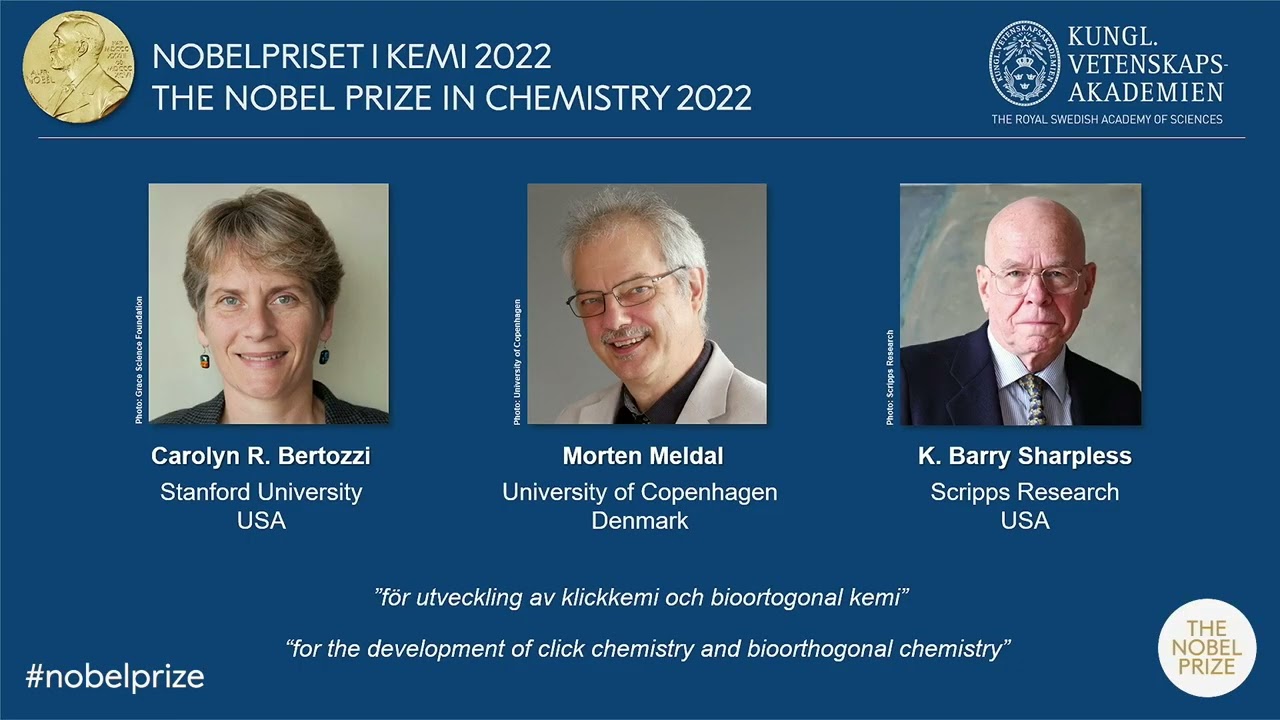Three Scientists Jointly Win Nobel Prize for Innovations in Click Chemistry
In the latest string of Nobel Prize announcements, the Royal Swedish Academy of Sciences jointly awarded the Nobel Prize in Chemistry to Carolyn R. Bertozzi, Morten Meldal, and K. Barry Sharpless for their work in click chemistry and bioorthogonal reactions. The novel approaches allow scientists to snap molecules together, providing the opportunity to more easily and efficiently develop new compounds to design medicines, map DNA, and create materials for particular purposes.

Click Chemistry’s Early Development
Constructing molecules is an incredibly complicated process that scientists worldwide have worked to simplify. Not only do molecules need to form strong linkages, but they also need to connect correctly to ensure the end product is suitable for targeted purposes. K. Barry Sharpless’ and Morten Meldal’s work in click chemistry provided a solution to these issues starting at the turn of the millennium.
The most recent Nobel Prize is Sharpless’ second after he won the coveted award in 2001 for his work on chirally catalysed oxidation reactions. During his previous work, Sharpless helped develop large compound collections called combinatorial libraries, which researchers could synthesize and test for pharmaceutical applications. After all the painstaking work involved in his previous work, Sharpless began his attempts to streamline the preparation process in compound construction.
In May 2001, alongside fellow chemists Hartmuth C. Kolb and M.G. Finn, Sharpless helped publish an article called “Click Chemistry: Diverse Chemical Function from a Few Good Reactions.” The article described how to use molecules to synthesize materials using a modular approach. Akin to a Lego set, the scientists found a way to snap molecules together to induce their desired reactions, laying the foundation for more accessible and efficient molecule construction.
Independent of Sharpless, Morten Meldal worked on the same approach around the same time. In 2001, while working on a different project, Meldal discovered that a certain copper species catalyzed the reaction faster than ever before. Again, independent of each other, Sharpless discovered copper’s crucial role in the process, broadening the scope of click chemistry’s applications.
Soon after their respective discoveries, the process took the chemistry community by storm as scientists worldwide recognized the value of click chemistry. Research projects around the world began to utilize the approach to leverage the concept to develop materials to target specific problems.
Related Article: Bill Gates Speaks at the Illumina Genomics Forum
Carolyn R. Bertozzi’s Bioorthogonal Reactions Research
Despite the fact that many researchers wanted to use the copper reaction in living organisms, copper’s toxicity limited the use of the process, driving some researchers to develop new ways to leverage click chemistry in biology. Carolyn R. Bertozzi made some of the biggest leaps in the field with her work in bioorthogonal reactions.
By altering Sharpless and Meldal’s reaction process, Bertozzi could use the concepts of click chemistry in living organisms like mice, allowing research in the area to focus on biology. She later called these processes bioorthogonal reactions, which could occur in living organisms without being affected by or interfering with surrounding biological processes. The in vivo applications marked an important milestone in the field, opening the door to important pharmaceutical development prospects.
Click chemistry and bioorthogonal reactions have greatly influenced chemistry and related science fields. Simplifying and expediting molecule construction has led to unprecedented feats in pharmaceutical development, DNA mapping, and material construction for targeted purposes. The effects of Sharpless’, Meldal’s, and Bertozzi’s work continue to have significant impacts throughout the global science community. The trio’s jointly awarded Nobel Prize is well-warranted as scientists worldwide continue to benefit from and build off their discoveries and achievements.
Along with the Nobel Prize in Chemistry, the Royal Swedish Academy of Sciences awarded this year’s Nobel Prize in Physiology or Medicine to Sweden’s Svante Pääbo for his work on genomes related to extinct hominins and Homo sapiens. His research linked the genetic data of extinct hominins like Neanderthals and Denisovans to modern Homo sapiens, giving rise to the new field of paleogenomics.
©www.geneonline.com All rights reserved. Collaborate with us: service@geneonlineasia.com








